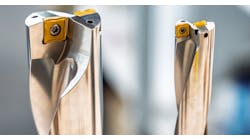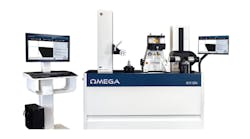Machining cell output increased two to three times for Haas Automation, with no fixture set-up necessary, following installation of the new double-acting HDM690 hydraulic vise set-up from Kurt Manufacturing.
Haas Automation Inc. is the largest manufacturer of CNC machine tools in the Western Hemisphere, so its own choice of machining technology is a reliable indicator of productivity and process quality. Recently, Haas phased-in an automated machining cell using a new model Kurt Manufacturing Co. workholding set-up that brings the capability to increase output by two to three times, according to Phillip Linscheid, machine shop manager at Haas Automation in Oxnard, Calif.
“The goal with the new workholding set-up was to automate the milling operations used to produce our machining center spindle shafts in a cell with two lathes and a milling machine tended by a Motoman Hp 165 robot,” Linscheid reported. “The robot provides the load/unload operations for each of the three machines. There is no fixture set-up labor required. The cell operates automatically during the 8-hour day shift and continues to run unattended through the night.
“We’re operating continuously 20 to 21 hours a day with this new cell, depending on quantities required,” he continued. “We’re achieving two to three times greater output for different size spindle shafts versus the previous set-up. We’re able to get that kind of productivity increase without needing a machine operator for the nighttime hours.”
Linscheid explained that the new Kurt double-acting hydraulic vise gives Haas the automated and repeatable clamping needed in the cell set-up. Using hydraulic pressure, the double-acting design ensures that the moveable jaw opens and closes precisely, with up to 6,000 lbs of clamping force actuated by the machining center’s computer numerical control programming. (Single-acting hydraulic clamping devices close with hydraulic pressure but use a less precise spring mechanism for reopening, so they aren’t designed for automated CNC machining set-ups.)
Note the custom machined jaw in the photo above. The hydraulic vise does all of the work of a custom fixture but can be used for other set-ups simply by changing jaws. In the photo below, the vise is equipped with standard fast-change jaw plates.
To facilitate automated part handling, the machining centers and robot are pre-programmed with the correct load/unload position. To begin, the machining center positions the fixture in the load position and the robot inserts the workpiece into the vise jaws, which then clamp the part. The robot exits the machine and the machining cycle begins. When machining is completed, the robot moves back into position, grasps the finished part as the vise jaw opens. The robot moves and stacks the part in an offload station. This cycle repeats with the robot picking up a new workpiece for placement in the vise jaws.
The new Kurt vise is mounted vertically on a holding fixture in a Haas VF 4 SS with 12,000-rpm inline direct-drive spindle. This Haas machining center achieves top-quality surface finishes, with thermal stability while maintaining a very quiet operation. The vise is an ideal workholding choice for this machine because of its many performance features.
The jaws of the vise are custom machined for clamping the spindle shafts, which vary in length from 14.32 up to 17.14 in., and are held to a 2.362-in. diameter. The dedicated steel jaws have been machined to hold specific part diameters so there is no need to change jaws between set-ups.
As for the machining process, both accuracy and speed are required while maintaining a high-quality finish overall on all part surfaces. The spindle shafts are made of 86L20 steel with machined drive dogs at the shaft ends. Machine speeds and feeds on these spindles range from 1.0-in. end-milling operations at 2,700 rpm and 28.0 inches per minute, to 0.375-finish end-milling at 3,056 rpm and 20.0 in. per minute. While the part-clamping requirement is very high, Linscheid explained that the new vise holds tolerances of +0.005-0.000, without any variations to date.
Haas Automation’s new HDM690 has several new features over previous Kurt vise models. Foremost, the vise has a full 9-in. jaw opening, so there’s ample capacity for large spindle diameters and other large parts when needed. The vise’s top-down bolting and tall body design is a new feature, for reduced deflection. A narrower vise body allows for more vises in the work envelop should more clamping stations be required.
The Kurt HDM690 vise also has high-precision roller bearings and a specially hardened vise screw mechanism enhancing precision clamping and smooth operation. This design distributes up to 6,000 lbs of clamping force evenly and precisely across the full jaw surface. Kurt’s patented AngLock® spherical segment in the moveable jaw further reduces jaw lift. The pull-type body design stabilizes stress in the vise body resulting in accurate clamping for Haas cylindrical spindles as well as flat and irregularly shaped parts.
Linscheid indicated he liked the ruggedness of the Kurt HDM690 Double Acting vise models. Made of 80,000-PSI ductile iron, the vise bodies provide strength, rigidity and long-term accuracy while absorbing even slight machining vibration. Also, the vises have enclosed screws and clamping mechanisms so chips don’t foul up the hydraulic clamping mechanism: they clamp and unclamp quickly and accurately with each cycle.
Easy set-up features of this new vise include a stationary jaw that bolts down from the top, so there is no need to remove the vice from the table for disassembly. Bolting the stationary from the top reduces the stress in the body and keeps it flatter after assembly. The vise has a movable jaw allowing for quick-change ability, to hold the cylindrically shaped Haas spindles.
According to Linsheid, Haas machines 200 to 400 spindles each workweek using the Kurt HDM690 vise. The set-up has been in operation successfully for about a year, and a second cell incorporating another HDM690 vise set-up is nearing completion. It will be phased in as production orders increase. “We would not be capable of machining these spindle shafts in a robot cell without the Kurt HDM690’s,” Linsheid reported. “They were introduced at a good time and helped us increase productivity while lowering our costs.”






